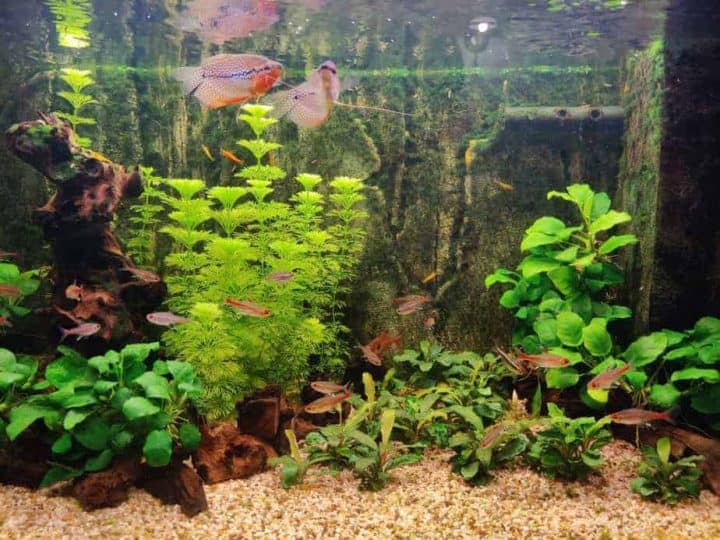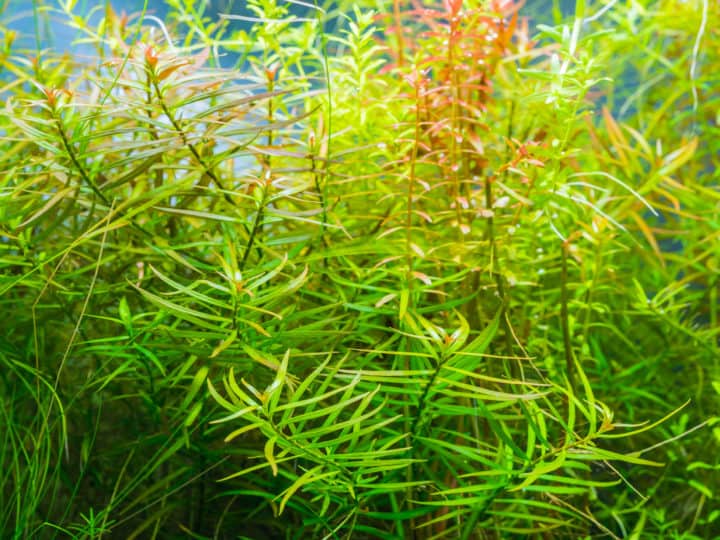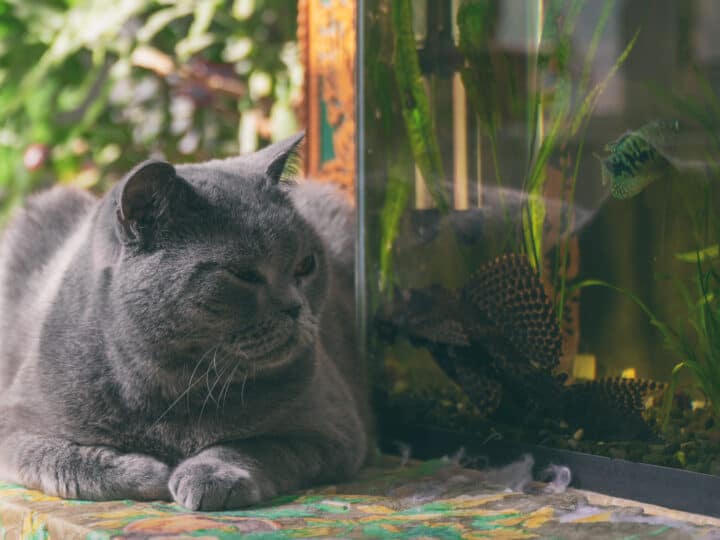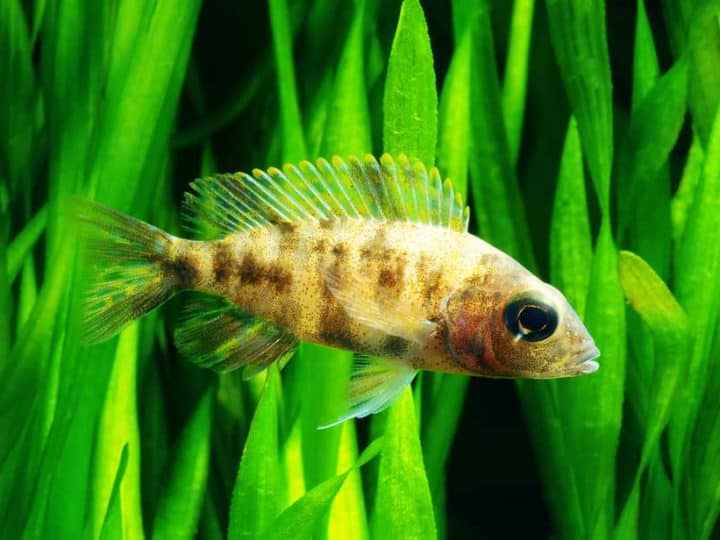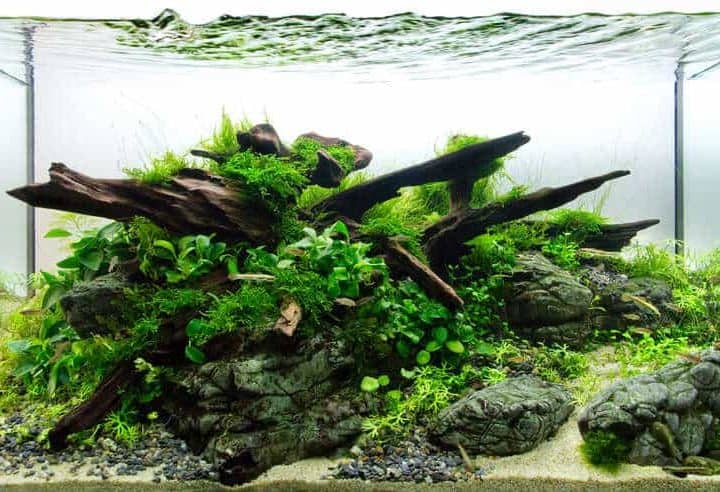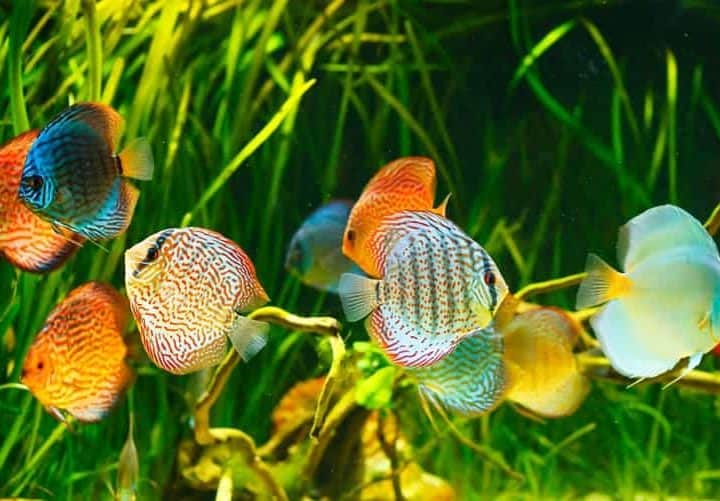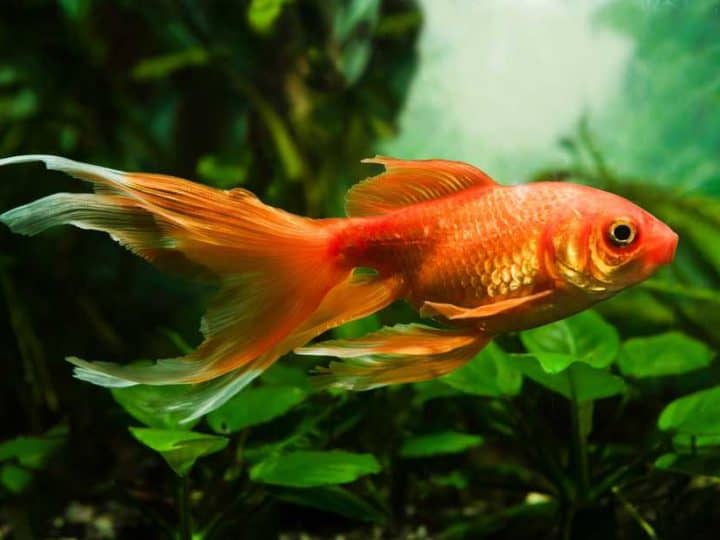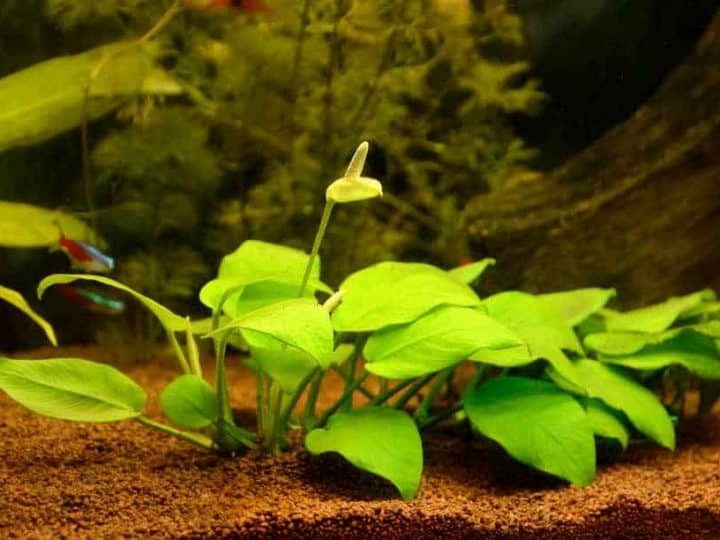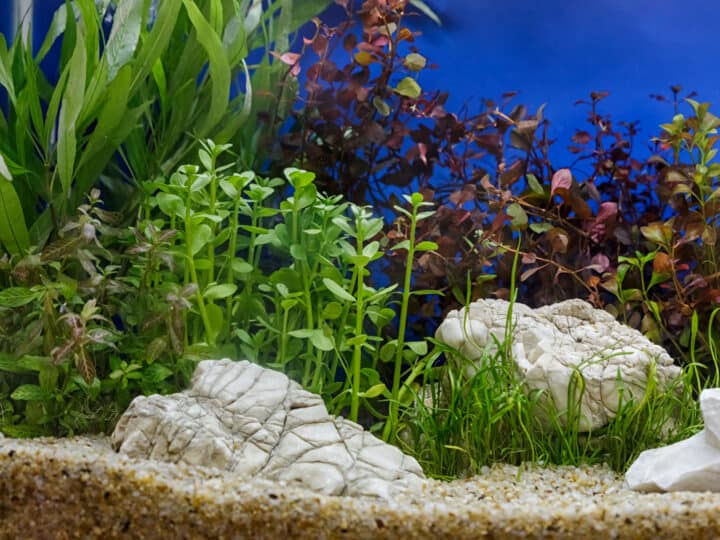For a new aquarium I was looking to add sand as a substrate, however I was unsure what plants would be able to live in sand. Therefore I asked several other aquarium owners to learn from their experience. This is what I found.
There are multiple plants that are able to grow in sand. However just sand does not provide nutrients so adding root tabs is advised when the plants rely heavily on their roots. Other plants take their nutrients straight from the aquarium water.
In the rest of the article I will show you pictures of all the plants together with crucial information to allow the plants to thrive. However before this, there is something you need to know about fertilization.
What it takes to allow plants to grow in sand
Whenever you are growing plants in sand, you need to know that just plain sand does not hold any nutrients for your plants. Therefore, you need to add root tabs to the soil on the places where you want to grow plants. These tabs will provide nutrients and allow your plants to grow. A more expensive alternative is to use a layer of nutrient rich aquarium soil, but if you’re anything like me that’s way to expensive. Luckily root tabs are way more affordable.
I always recommend root tabs from the brand “API” and have been doing so for a long time. They are available here on Amazon, and if you buy through my link you directly support me and this website. I really appreciate that, and it does not cost you anything extra!
If you’re curious what other brands and types of root tabs are available, make sure to check this page on my site where I compare 5 popular root tabs.
Root tabs are not necessary when plants are good at sucking nutrients straight from the aquarium water. In that case, I will make sure to add this information to the description of the plants. Let’s dive straight into the first plant on the list!
1. Amazon Swords
The first plant on the list is the Amazon Swords plants, which is a rather big, beautiful plant with large long leaves. It grows extremely well in sand substrate and is quite easy to grow (however I have managed to kill one, so I’m not saying it is easy, I’m just saying the plant grows quickly under the right conditions).
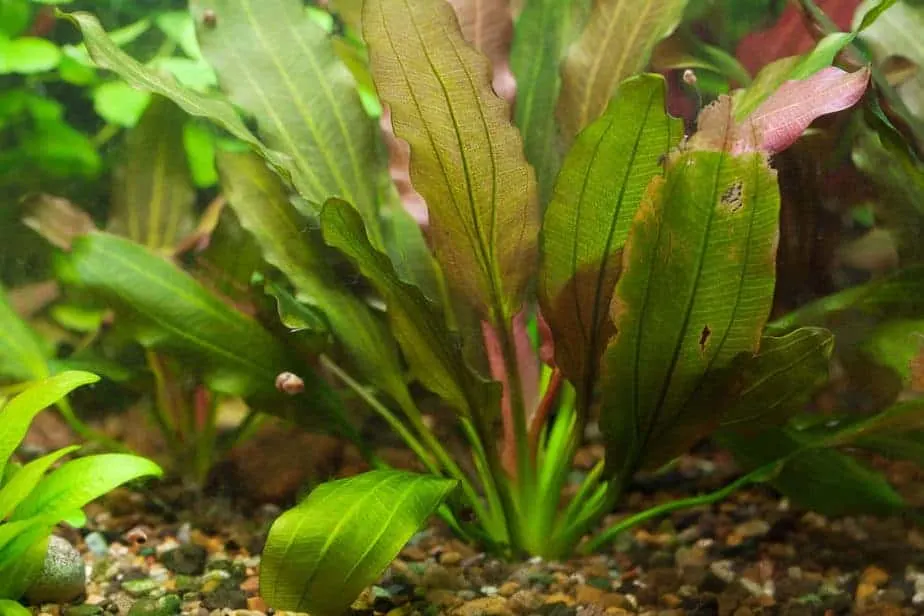
The plant is a heavy root feeder so make sure you add plenty of the root tabs we talked about earlier. Due to the rather big size of 16 inches / 40 cm tall and just about as wide this plant needs a lot of space. I remember buying two for my 20 gallon / 100 L aquarium and they grew to be way too big. The plant needs medium lighting.
If you want to prune the plant, you can remove leaves from the outside, as new growth will sprout on the inside of the plant. You can cut the leaves at the bottom.
Many people have successfully grown Amazon Sword in a fine sand substrate, including myself! Over a year after writing the original article I’ve come back to update this little paragraph. I’ve started a new aquarium with sand and have grown many plants in it.
Also know that there are many different types of aquarium sand available. On this page I’ve covered some of the popular variations with their up- and down- sides.
Let’s continue to the second plant.
2. Vallisneria
The second plant on this list is called Vallisneria and is an awesome plant with long waving leaves. Under the right conditions the plant propagates like crazy. It will do well in sand, and also needs some root tabs. It requires medium to high lighting.
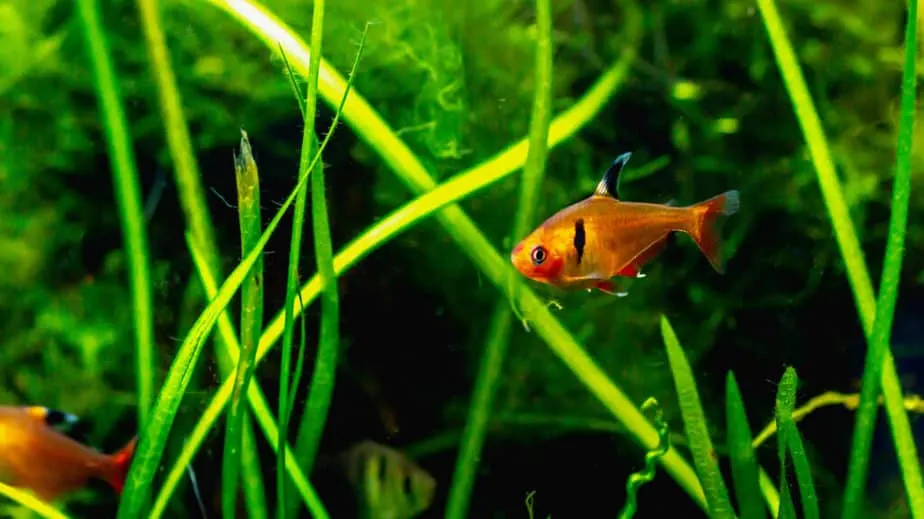
Vallisneria is an excellent plant to serve as a background plant. It propagates by shoots that move along the gravel called runners and daughter plants will rise every couple of inches/centimeter. When the plant is growing somewhere you would rather not have it, you can cut it loose from the others and plant is where desired.
These properties are perfect for creating a jungle for all your fish, and are ideal to create ways to break the line of sight for the fish which lowers their stress levels. This is because fish that can see each other all the time in a tank, no matter their position, some species feel threatened. A wall can block their vision and make them feel more safe.
3. Cryptocoryne
There are many different types of cryptocoryne (or “crypt” for short) that vary in size, shape, and color. They do well in the sand substrate as long as you provide them with enough nutrients like the root tabs we just talked about. I’ve also seen success when I just added liquid fertilizer. They are really hardy plants.
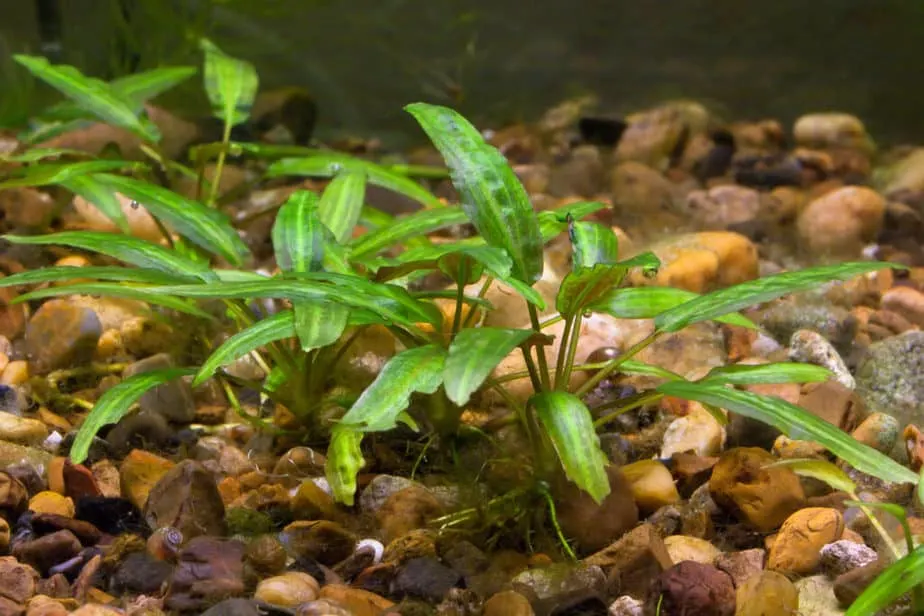
For crypts it is especially important that you keep the water conditions stable. Another common thing for crypts is to melt when you add them to your aquarium. Melting is a name for looking like the plants are dying, where instead they are getting rid of their leaves to grow new leaves. They do this because often the plants bought in store are grown outside of the water, and the new leaves are accustomed to being under water.
You might notice that this new growth has a different shape or color compared to the leaves the plant had when you bought it in the store. This can happen, and there is nothing you can do about it except asking the store whether their crypts are grown outside- or underwater.
4. Dwarf Hygro (Hygrophila polysperma)
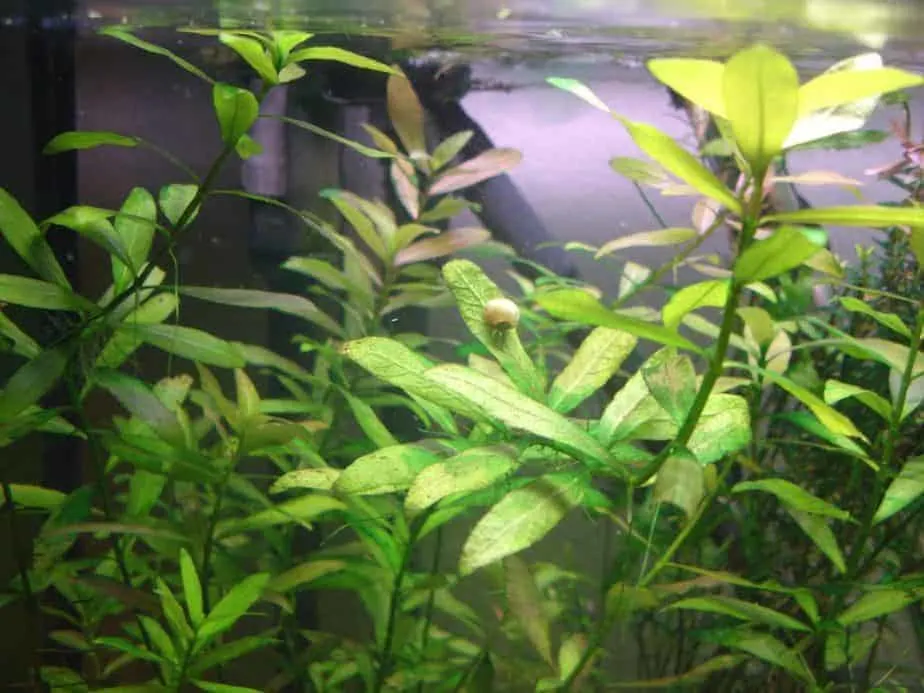
This plant is a little bit of an oddball as I have not found this anywhere else on the internet in lists of plants that grow in sand. However, I have experienced first hand that Dwarf Hygro grows well in sand. This plant is beautiful and grows really quickly when there is enough nutrients available. I personally add liquid fertilizer and inject pressurized CO2.
In contrast to some of the previous plants in this list, this plant is not a heavy root feeder and takes most of the nutrients from the aquarium water. Therefore this plant is also suitable to keep floating in the aquarium if you would like to. However you will find the plant growing a lot of roots when its floating. It’s best to keep it planted in sand/substrate.
5. Anacharis Elodea (water weeds)
If you are looking for a fast-growing, beautifully green aquarium plant I would say you do not have to look any further. This plant deserves his “waterweed” name as it grows super quickly under the correct circumstances. Personally, I have found this to be the easiest plant I have owned. It did the best in my aquarium without CO2. I just add the right dosage of liquid fertilizer. As a liquid fertilizer, I always recommend Leaf Zone by API, which you can check out here if you don’t own liquid fertilizer already.
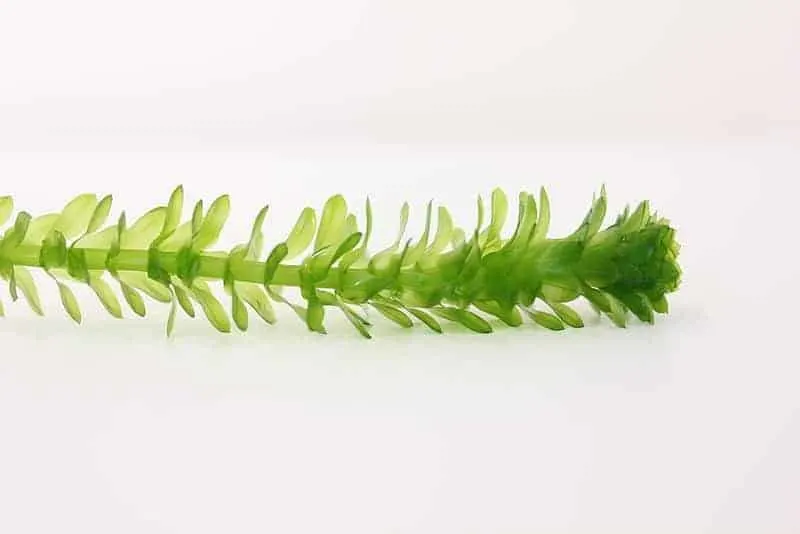
As you probably concluded by now, this plant does not need root tabs. It helps, but it is not necessary when you add liquid fertilizer.
Furthermore, as a stem plant, this plant can grow to be rather long. However, whenever you think the plant is growing too long you can cut the plant and stick the cutting back in the sand and it will continue to grow. This is a great way for propagating and eventually will give you so much plant you do not know what to do with it.
6. Hornwort
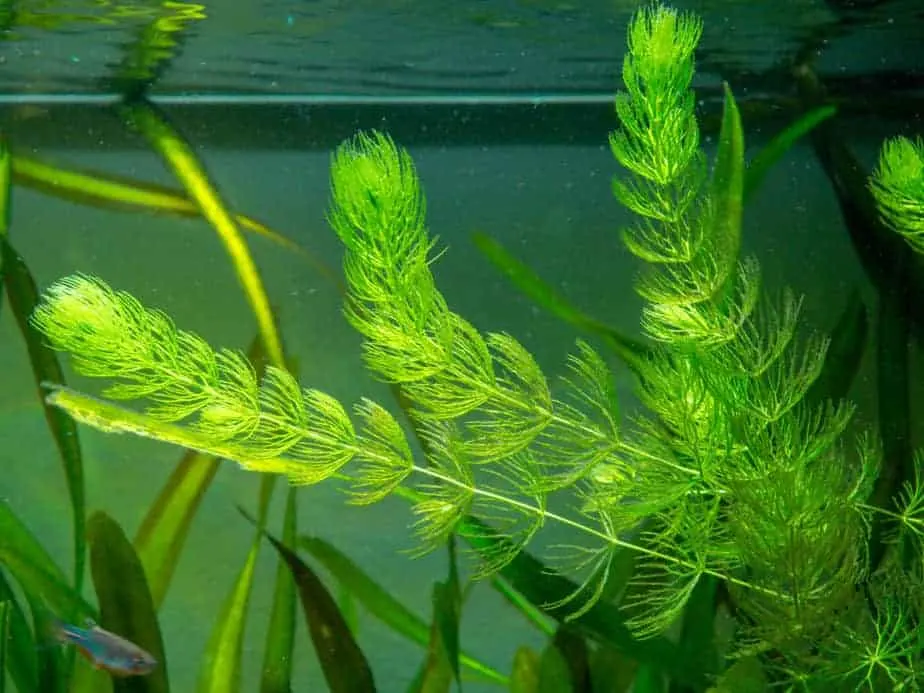
Hornwort is an extremely hardly plant that can grow in many environments. In nature, this plant has spread to all continents except Antarctica. While not really a good thing in nature, this is positive when keeping it in an aquarium.
It is a great beginner plant as it can handle many different water parameters. Also, the plant gets most nutrients from the water and is therefore not really dependent on its roots, which in turn makes it suitable for growing in sand.
Hornwort is also on my list of suitable aquatic plants for beginners, which can be found here on my website.
Keeping your hornwort alive is rather easy. You can propagate the plant by taking a cutting and pushing it back in the sand. From this cutting the plant is able to continue to grow.
7. Cabomba
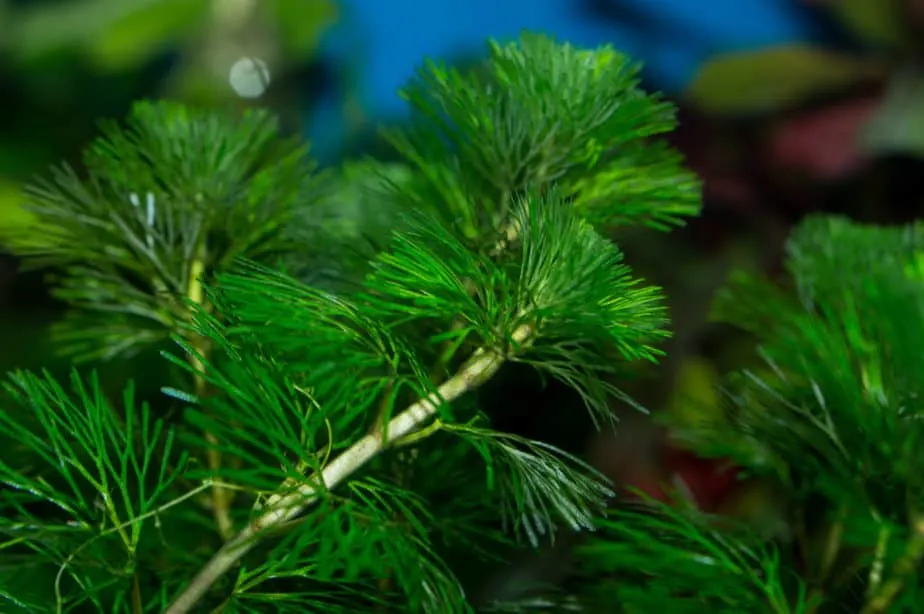
This plant with the beautiful name “Cabomba” is not a beginner plant. It is also not extremely difficult to keep it alive; however, it is not a beginner plant. The Cabomba plant can also suck nutrients straight from the aquarium water and therefore live in plain sand. Make sure to add liquid fertilizer.
This plant requires medium to high lighting and is easier to grow when there is sufficient CO2 in the water. For this you can use pressurized CO2 to inject in the water.
8. Tiger lots
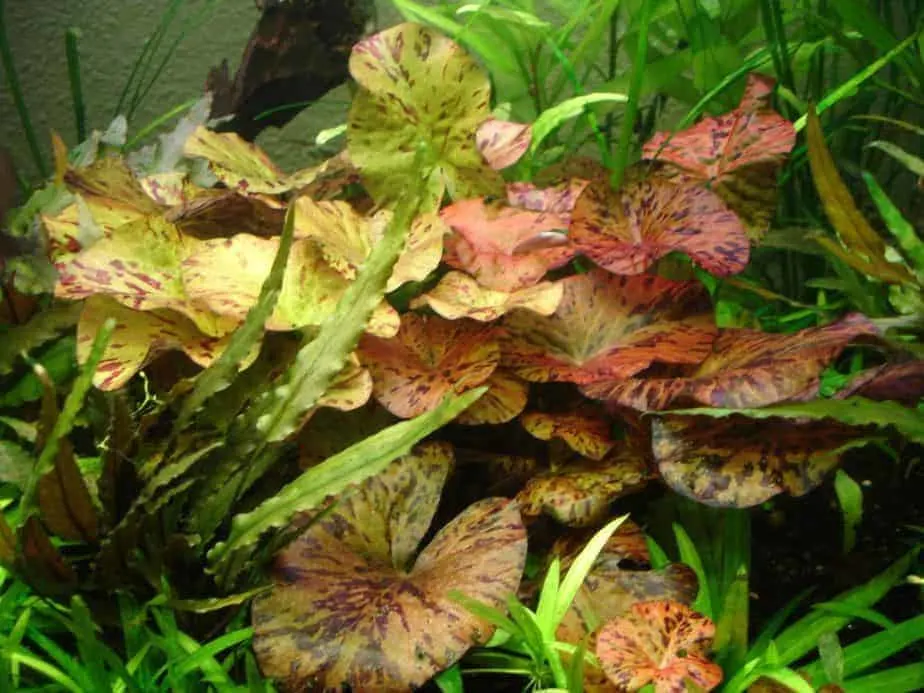
While I sadly was not able to find a nice image of the tiger lotus, it really is a stunning plant! You buy it as a small round ball and plant it in your sand or substrate. Make sure there is enough nutrients in the soil to feed the plant. Use root tabs or other forms of nutrients for this.
This plant grows red leaves, but when it thrives one large stem shoots for the water surface and creates a lily-pad-like leave. It is absolutely amazing to see one of these plants do well in your aquarium. I found the plant to be available on Amazon with a 3 day live guaranteed, so you can actually buy this plant online and have it shipped to your house.
I’ve grown this plant myself and received the tip to plant the plant in a small (plastic) container which you than in turn bury in your substrate. The reason for this is that the plant can easily take over an aquarium when it starts to do well. I’ve had mine in my tank for about 3 months now and it’s not growing out of control yet.
9. Java Moss
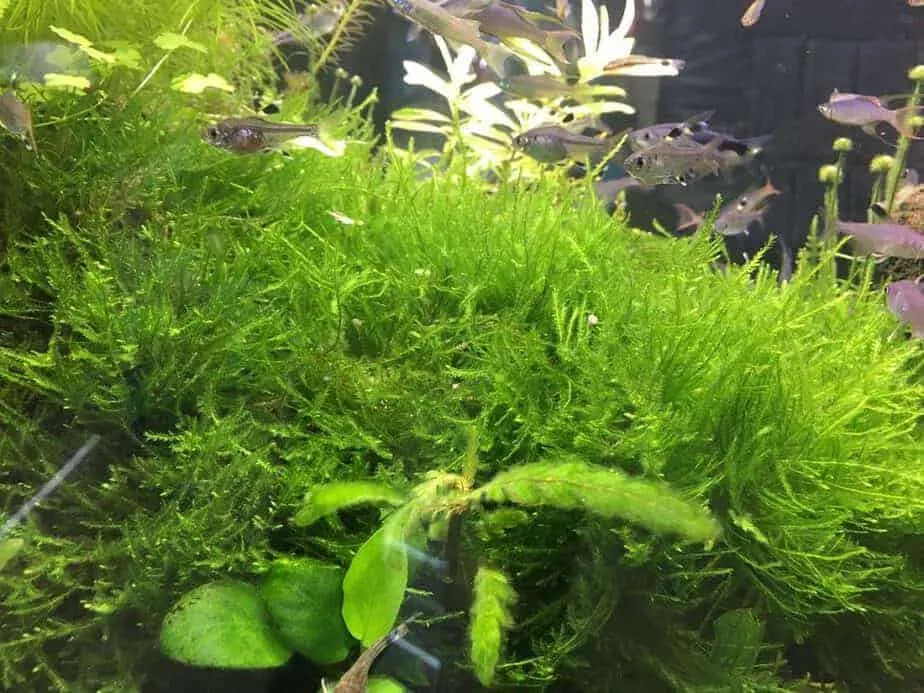
Moving on to the final three plants on this list. For these plants I am going to keep it short as they are extremely popular in the aquarium hobby and chances are you have heard of them. The first one is Java Moss, which is a versatile plant often used for aquascaping.
This plant is able to live on sand rather than in sand. To grow the moss to make a green carpet, make sure to weigh it down to keep it in place. There should be little current for the moss not to move, and there should be no fish that are able to disrupt the moss. If you have sufficient light (it does not need much) and enough nutrients in the water, the moss will slowly spread and get a grip on the sand over time.
Note that trying to grow moss as a carpet takes patience. Quite a lot of it. I would rather recommend attaching moss to a piece of driftwood or a rock. To do this, you can use fishing line or super glue.
Moss is another one of those plants that’s available on Amazon. You’ll receive the moss in small plastic containers and you are free to then use it however you like. Moss is really for everyone; both beginner and experienced fishkeepers. Check out this listing on Amazon to find the current price, and if you don’t have any moss yet I can really recommend it. You won’t be disappointed!
10. Anubias
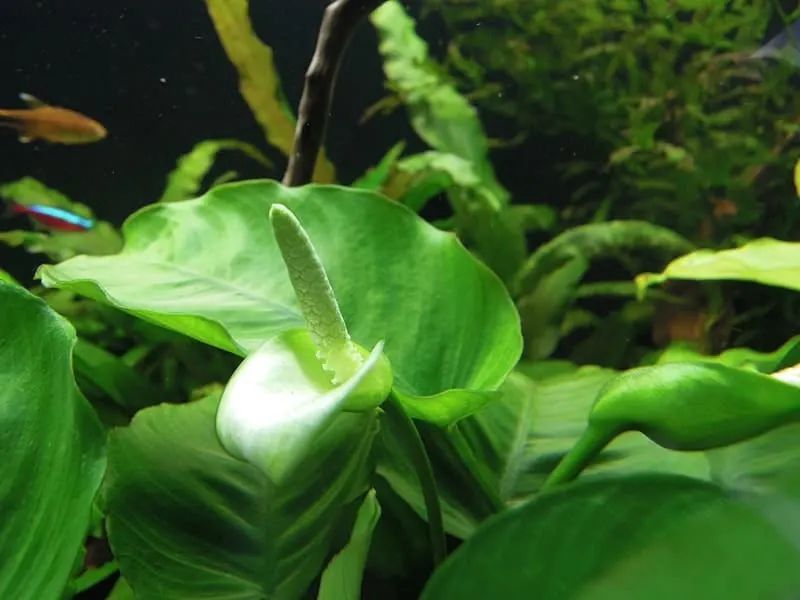
The anubias plant is a beautiful plant and probably one of my favorites. It is available in many different sizes, and the leaves are strong and a dark green color. The reason why this plant is in the list of plants that grow in sand is because you should not bury the roots. Therefore, it does not matter what substrate you have (or if any).
I know this is a bit of a silly reason as it technically is not able to grow in sand, however you can tie it to for example wood or rocks. I wrote an article about plants suitable for this.
If you do not have an anubias plant, pick one up at your local fish store. Due to popularity it is probably in stock. It needs low to medium light and takes its nutrients from the water. It is a slow growing plant, but really sturdy and can withstand destructive fish like goldfish or other bigger fish. P.S. please do not keep goldfish in an aquarium, rather put them in a nice and big pond as they are going to need the space. And yes, I have kept them in a bowl and aquarium when I started, however they just are not suitable.
11. Java Fern
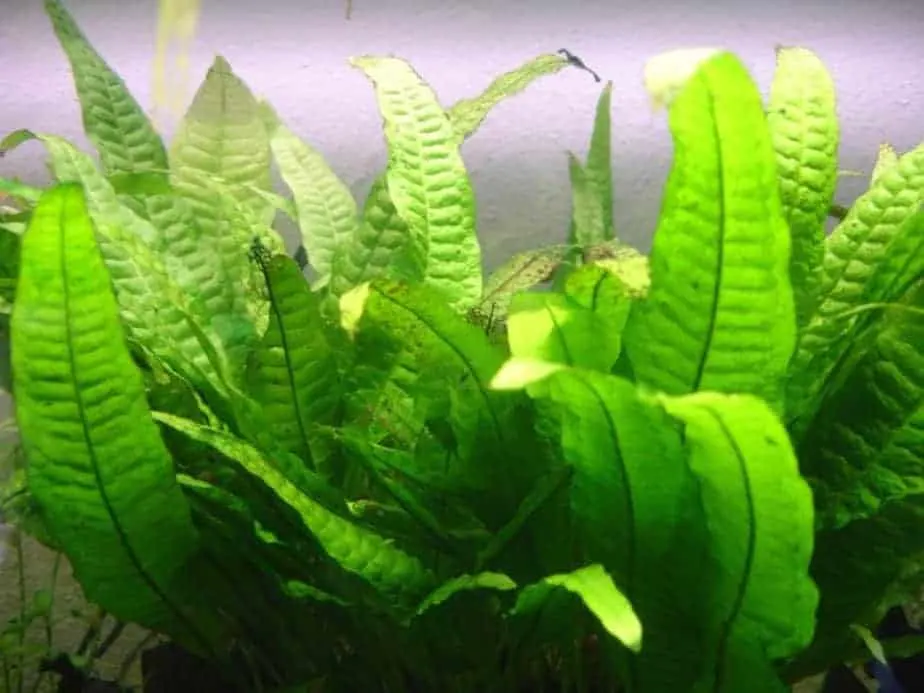
Last one on the list is the java fern. This is arguably the most popular aquarium plant in our hobby. It needs low light and can do well without CO2. It does need nutrients however, so make sure to add some liquid fertilizer. What you should know about this plant is that you can not bury the roots. Instead, attach it to a piece of wood or rocks.
In my experience this plant propagates by itself, but it requires patience. After a couple of months I saw a baby java fern sitting somewhere in the tank. They start to grow on the big leaves of a big plant, and at some point detach. Current drives them to a place where they attach themselves as they grow bigger. In short: awesome plant. Low tech.
My favorite fishtank products that make life easier
I am so happy you enjoy this post so far! You will also definitely like my product recommendations that will make your fishkeeping experience so much better. I’m 100% sure you’ll love them!
- Without a gravel vacuum, like one from Aqueon, cleaning the substrate of your tanks is near impossible. Whenever I want to remove some of the sunken detritus from the bottom of my acrylic tanks I’m happy I’ve got one of these.
- It’s no secret that I do not like nutritious aqua-soil. It makes a mess and only works for a given amount of time. Instead, I always use a liquid aquarium plant fertilizer. Everyone who keeps live plants needs it, it’s not that expensive and makes your plants grow better.
- I love keeping plants, but planting and reorganizing my aquarium was difficult until I got a set of these tools. It’s much easier to plant any kind of plant compared to using my thick fingers.
- Ever since I’m able to accurately test my water parameters, including the pH level, keeping fish became less stressful. Before I was always stressed that my water parameters were wrong, but with a kit such as the API Master kit, I can measure this. It really is essential to successful fishkeeping.
- The more you know about your aquarium, the better! Temperature is crucial for the health of your fish. A thermometer will also show you whether your heaters are still working correctly. It will give you more insight and more peace of mind. It’s an easy way to ensure that you’re providing your fish with the tropical temperatures they need.
References:
Cabomba image – Author:Piotr Kuczynski Licensed under: CC3.0 No changes made
tiger lotus image – Author: Pinpin Licensed under: Creative Commons Attribution-Share Alike 1.0 Generic No changes made
moss photo owned by Ranjith-chemmad licensed under CC 4.0
anubias photo 1 owned by Tocekas licensed under CC3.0
Java Fern Image – Author: User:Pinpin Licensed under: CC1.0 No changes made

